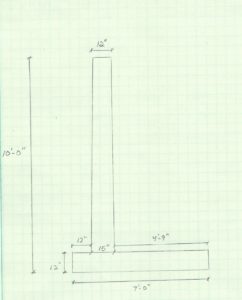With an embankment height of 10 feet, the bridge abutment dimensions were determined as indicated on the drawing provided. Because the abutment is supported by piles, the bearing capacity was not determined for the soil directly beneath the abutment. The wall was checked for sliding and overturning. For sliding, the resistance force was calculated to be approximately 5,000 lb/ft with a driving force of 3,500 lb/ft. The abutment was resistant to sliding along the base. For overturning, the resistance moment was calculated to be 31,000 lb*ft/ft and the overturning moment was 13,500 lb*ft/ft. The abutment was safe from overturning.
All posts by Kevin Gurski
Soil Properties
After determining the soil profile, soil properties for each stratum were calculated. For the cohesive layers (C and E), laboratory test results for unit weight, compression ratio, recompression ratio, pre-consolidated stress, and cohesion provided by TerraSense were averaged. For the granular layers (A,B,D,F), the unit weight, angle of friction, bearing capacity, and compression ratio were calculated by empirical graphs using the average SPT value for each individual layer.
|
Stratum |
Unit Weight (pcf) | Angle of Friction (degrees) |
C’ |
CR |
RR |
Pre-Consolidated Stress (ksf) |
Cohesion (ksf) |
| A | 110 | 33 | 68 | 0.014 | |||
| B | 100.00 | 31 | 46 | 0.022 | |||
| C | 93.82 | 0.287 | 0.03 | 1.6-4.0 | 0.46 | ||
| D | 120 | 33 | 55 | 0.018 | |||
| E | 119.5 | 0.119 | 0.03 | 21.8 | 1.76 | ||
| F | 130 | 39 | 95 | 0.011 |
Soil Profile
The team created a soil profile using the selected boring logs explained in the site plan update. The soil was separated into 6 strata. The top layer consisted of fill while the next layer was comprised of loose sand. The largest of the strata was the organic clay which was approximately 60 feet thick located at an elevation of about -10 feet. After the organic clay, a thin layer of sand was present followed by a stiff clay layer. The lowest layer explored was a dense sand layer approximately 95 feet deep.


